The Duck Plucker Machine Market is estimated to be valued at USD 308.2 million in 2025 and is projected to reach USD 506.8 million by 2035, registering a compound annual growth rate (CAGR) of 5.1% over the forecast period.
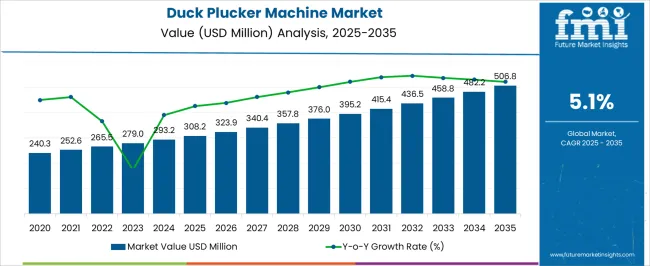
| Metric | Value |
|---|---|
| Duck Plucker Machine Market Estimated Value in (2025 E) | USD 308.2 million |
| Duck Plucker Machine Market Forecast Value in (2035 F) | USD 506.8 million |
| Forecast CAGR (2025 to 2035) | 5.1% |
The duck plucker machine market is expanding steadily, driven by the rising demand for efficient poultry processing equipment and the need to reduce manual labor in slaughtering operations. Increasing consumption of duck meat across both developed and emerging markets has fueled investments in advanced plucking machinery that ensures speed, consistency, and hygiene.
Stainless steel construction and automated designs are becoming standard due to their durability, compliance with food safety regulations, and resistance to contamination. Manufacturers are focusing on developing compact and energy efficient machines suitable for both commercial processors and small scale users.
Growing awareness of food handling standards and emphasis on productivity enhancement are strengthening adoption. The market outlook remains favorable as modernization in poultry processing facilities continues and as consumer demand pushes producers to adopt reliable and hygienic processing technologies.
The market is segmented by Type and Material and region. By Type, the market is divided into Vertical and Horizontal. In terms of Material, the market is classified into Stainless Steel, Mild Steel, and Others. Regionally, the market is classified into North America, Latin America, Western Europe, Eastern Europe, Balkan & Baltic Countries, Russia & Belarus, Central Asia, East Asia, South Asia & Pacific, and the Middle East & Africa.
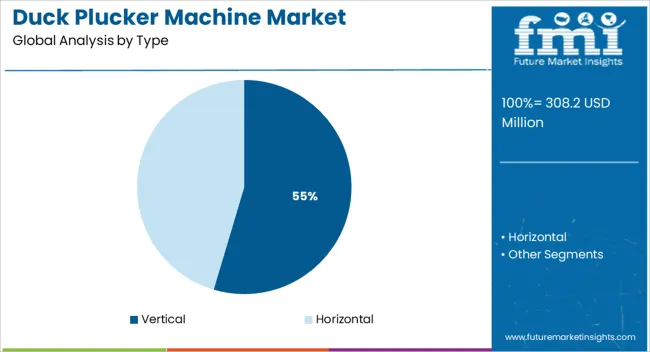
The vertical type segment is projected to account for 54.60% of total market revenue by 2025 within the type category, making it the leading format. This dominance is attributed to its space saving design, ease of installation, and suitability for both small scale and commercial poultry operations.
Vertical machines provide consistent feather removal with reduced manual intervention, improving efficiency and ensuring better hygiene. Their popularity has been reinforced by the demand for compact machinery that delivers high throughput in processing environments where space and operational efficiency are priorities.
The adaptability of vertical systems to different bird sizes further supports their widespread use, positioning this segment as the preferred choice for end users.
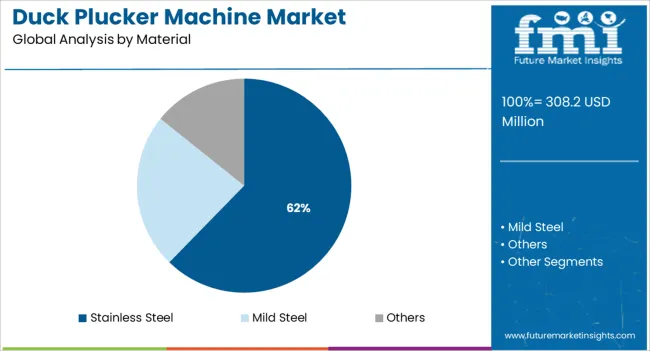
The stainless steel material segment is expected to represent 62.30% of total revenue by 2025 within the material category, establishing it as the dominant choice. This preference is driven by the durability, corrosion resistance, and compliance with international food safety standards that stainless steel provides.
Machines built with stainless steel are easier to clean, maintain, and sanitize, which reduces the risk of contamination in processing environments. Longevity and reliability of equipment made from this material have also justified its higher initial investment.
The growing regulatory emphasis on hygiene in meat processing has further accelerated adoption. As a result, stainless steel remains the material of choice for duck plucker machines, ensuring sustained leadership within this segment.
When compared to the 4.6% CAGR recorded between 2020 and 2025, the duck plucker machine industry is predicted to expand at a 5.1% CAGR between 2025 and 2035. The average growth of the market is expected to be approx 72.8% between 2025 and 2035.
| Year | Market Value |
|---|---|
| 2020 | USD 203.1 million |
| 2024 | USD 253.9 million |
| 2025 | USD 265.5 million |
Short-term Growth (2025 to 2029): the market is anticipated to rise in the short run due to an increase in duck farms and an increase in demand for duck meat.
Medium-term Growth (2035 to 2035): the numerous health benefits of goods made from duck protein are a contributing factor in the rising demand for plucker machines.
Long-term Growth (2035 to 2035): the development of automated duck pluckers is one amazing technology that is likely to contribute to the market's expansion.
There are opportunities to expand the industry if new end users, like restaurants, are sought. Restaurants are adopting duck plucker machines more frequently to save time and money, and this could be a fantastic chance for manufacturers to reach out to new clients.
These reasons would likely lead to a 1.64x increase in the duck plucker machine sector between 2025 and 2035. FMI analysts predict that the market would be worth USD 506.8 million by 2035's end.
Surging Need for Organic Food Products
The market is projected to be driven by the rising demand for natural and organic foods. Organic poultry farms are increasingly using machines to cut labor costs and enhance product quality. Additionally, rising consumer awareness about organic food advantages is likely to fuel the demand for duck plucker machines.
Ready-to-eat Trend
The duck plucker machine industry is projected to expand as a result of the rising demand for poultry products that are ready-to-eat (RTE) and ready-to-cook (RTC). The market share increases as RTE and RTC poultry products gain popularity, as they can be processed more quickly and efficiently.
Reduce the Chance of Manual Handling
The market is expected to be driven by the growing emphasis on product safety and cleanliness. The adoption of a duck plucker machine is anticipated to minimize contamination risk and reduce manual handling, enhancing product safety and cleanliness.
Based on Type
Due to its widespread use in poultry farms, the vertical category is anticipated to dominate the market share by 2035. In addition, compared to the horizontal segment, the vertical segment is more efficient and economical.
Due to their high nutritional value and deliciousness, duck products are in great demand in the food service sectors, which fuels market expansion. Commercial duck plucking equipment is also a crucial component of poultry farms, due to its increased effectiveness and affordability.
Based on Material
Over the projected period, the market's stainless steel sector is anticipated to expand significantly. This is due to the increased demand for stainless steel plucking equipment due to its superior qualities, including corrosion resistance and longevity.
During the forecast period, the mild steel sector is anticipated to expand at a moderate rate. This can be explained by the mild steel plucking machines' lower price and wider availability as compared to stainless steel ones.
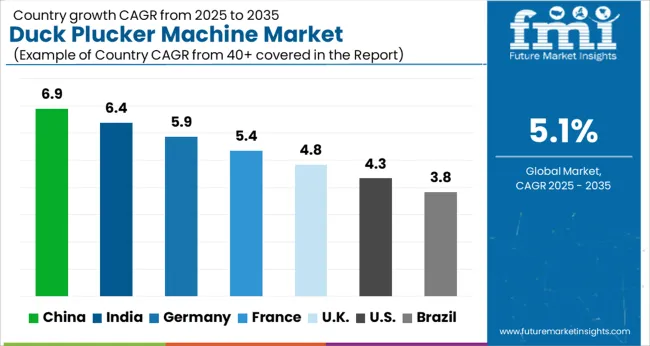
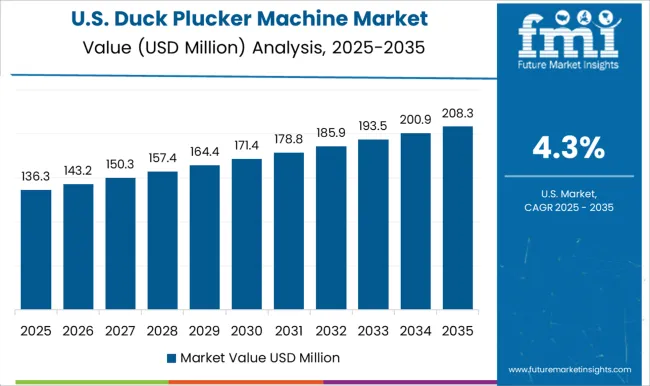
The USA market has been continuously expanding. This is due to a higher demand for duck plucking equipment, as specialist breeds of poultry gain popularity.
According to FMI Statistics, the market in the USA was estimated to be worth USD 308.2 million in 2025 and has a share of 29.9%. This growth rate can be linked to the expansion of backyard and hobby farms, as well as the rising demand for high-quality chicken products.
The market is expanding due to key factors like the rising usage of automated plucking methods and rising investments in technological improvements. Small-scale poultry farmers for duck plucking machines are contributing heavily to the market share.
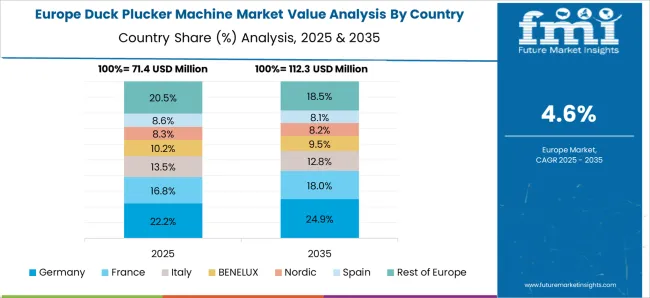
The market in Germany was estimated to be worth USD 48.2 million in 2025 and has a share of 18.2%.
Germany's market is developing, thus there is an opportunity for anyone seeking to enter the market. Only a few companies are now selling duck-plucking equipment in Germany, with domestic firms controlling the majority of the market.
However, the industry is gradually starting to open up to foreign businesses, especially those from China, the United Kingdom, and the USA. Due to the rising demand for duck and poultry products, the German market is anticipated to expand steadily.
The nation's increased emphasis on animal welfare programs and the rising demand for organic and free-range poultry products both contribute to this expansion. Companies are thinking about creating their own cutting-edge machines that are adapted to the local market to take advantage of the German market potential.
To develop, promote, and distribute their devices, corporations must think about forming partnerships with regional businesses. Companies can also look for chances to work with regional research organizations to create new technologies that can be utilized to increase the speed and precision of the plucking process.
Finally, businesses should think about boosting their marketing initiatives to reach Germany's burgeoning poultry producers and processors.
| Attributes | Statistics |
|---|---|
| United Kingdom Market Value 2025 | USD 25.2 million |
| United Kingdom Market Value 2035 | USD 42.9 million |
| United Kingdom Market Share (2025 to 2035) | 9.5% |
| United Kingdom Market CAGR (2025 to 2035) | 5.5% |
The trend in the United Kingdom market reflects increased demand for duck plucker machines as farmers seek to automate their duck meat production. In addition, the growth of the market is further supported by the introduction of new and improved duck plucker machines. Recent projects in the United Kingdom proved to be beneficial for overall revenue generation.
The market has seen steady growth in 2025, with a worth of USD 506.8 million. In recent years, more people have taken to eating duck meat as a healthy alternative to other meats, such as beef and pork. Due to this, the China market is expected to develop at a CAGR of 4.1%, with a value of USD 40.0 million by 2035.
Chinese businesses are constantly working to improve processing effectiveness. Market leaders continually prioritize development to gain an advantage over their competitors.
| Companies | Processing Efficiency |
|---|---|
| Hangzhou Xingwang Machinery Co. Ltd. | 30 Ducks |
| Guangzhou Yuyang Food Machinery Co., Ltd | 6 Ducks |
| Beijing Yileli Machinery Co., Ltd | 10 Ducks |
| Shanghai Jiejia Machinery Co., Ltd. | 20 Ducks |
According to FMI Statistics, the market in India was estimated to be worth USD 10.6 million in 2025 and have a share of 4%.
National Hatcheries is one of the leading businesses in India's industry for duck plucking devices. The company offers a wide range of machinery that may be applied to different poultry processing methods. The company also produces machines to order and provides after-sales services.
JBT FoodTech is a key player in the Indian market. The company sells equipment designed specifically for a given purpose. To encourage the use of duck-plucking machines in India, there are a number of public and private initiatives.
These programs include giving farmers support and training, in addition to defraying the cost of the equipment. In the upcoming years, these measures are anticipated to expand India's market value of USD 18.9 million, with a CAGR of 6% by 2035.

Collaboration Helps Duck Plucker Machine Start-ups to Activate Boost Start
Duck plucker machine startups can take advantage of a number of resources, including those for product design and development that are industry-specific. In order to reach their client base and gain access to their expertise, startups can look for collaboration with established players like poultry processors.
Start-ups think about establishing a presence at pertinent trade exhibitions and conferences to increase awareness and build a network of possible partners.
Finally, new businesses should study the poultry industry's rising trends, like automation and robotics, to spot chances to create inventive duck plucker equipment.
A few startups are investigating the use of artificial intelligence (AI) to develop more intelligent and effective plucker devices. AI-powered devices can identify the size, breed, and level of plucking needed, which results in more accurate and efficient plucking.
How do Key Players in the Duck Plucker Machine Industry Expand their Customer Base?
Duck plucker machine manufacturers can consider extending their product line to accommodate chicken and turkey as additional poultry options. This can broaden the market's potential client base and open up new growth chances. Moreover, leading players are adopting strategies to overcome the challenges faced by the market.
| Market Challenge | Equipment Maintenance and Awareness |
|---|---|
| Manufacturers’ Solution | Focus on Customer Service |
| Details | Manufacturers should make sure to offer top-notch customer service. This involves delivering prompt customer service, valuable guidance, and reasonable pricing. |
| Market Challenge | Limited Market |
|---|---|
| Manufacturers’ Solution | Adopt a Global Strategy |
| Details | To expand their market share and tap into new markets, manufacturers should embrace a global strategy. This can entail setting up collaborative ventures with regional businesses or extending into new nations or areas. |
| Market Challenge | Outdated Technology |
|---|---|
| Manufacturers’ Solution | Utilize Digital Strategies |
| Details | Manufacturers should use digital tactics to increase the effectiveness of their processes. This can entail building an online store for customers to buy their items, automating operations to expedite them, or using social media to market their goods. |
Finally, producers might concentrate on producing more sophisticated and effective tools that could shorten the time and labor required to pluck ducks, thereby raising demand.
The global duck plucker machine market is estimated to be valued at USD 308.2 million in 2025.
The market size for the duck plucker machine market is projected to reach USD 506.8 million by 2035.
The duck plucker machine market is expected to grow at a 5.1% CAGR between 2025 and 2035.
The key product types in duck plucker machine market are vertical and horizontal.
In terms of material, stainless steel segment to command 62.3% share in the duck plucker machine market in 2025.
The global duck plucker machine market is estimated to be valued at USD 308.2 million in 2025.
The market size for the duck plucker machine market is projected to reach USD 506.8 million by 2035.
The duck plucker machine market is expected to grow at a 5.1% CAGR between 2025 and 2035.
The key product types in duck plucker machine market are vertical and horizontal.
In terms of material, stainless steel segment to command 62.3% share in the duck plucker machine market in 2025.






Full Research Suite comprises of:
Market outlook & trends analysis
Interviews & case studies
Strategic recommendations
Vendor profiles & capabilities analysis
5-year forecasts
8 regions and 60+ country-level data splits
Market segment data splits
12 months of continuous data updates
DELIVERED AS:
PDF EXCEL ONLINE
Duckweed Market Insights – Trends, Demand & Growth 2025–2035
Duckweed Protein Market Insights – Demand, Size & Industry Trends 2025–2035
Duck Boots Market Trends - Growth & Industry Outlook 2025 to 2035
Japan Duckweed Protein Market Analysis by Nature, Species, End Use Application, and Region Through 2035
Korea Duckweed Protein Market Analysis by Nature, Species, End Use Application, and Region Through 2035
Europe Duckweed Protein Market Trends – Size, Demand & Forecast 2025–2035
Western Europe Duckweed Protein Market Analysis by Nature, Species, End Use Application, and Country Through 2035
Plucker Machine Market Size and Share Forecast Outlook 2025 to 2035
Commercial Chicken Plucker Market Size and Share Forecast Outlook 2025 to 2035
Machine Glazed Paper Market Size and Share Forecast Outlook 2025 to 2035
Machine Glazed Kraft Paper Market Forecast and Outlook 2025 to 2035
Machine Condition Monitoring Market Size and Share Forecast Outlook 2025 to 2035
Machine Glazed Paper Industry Analysis in Asia Pacific Forecast Outlook 2025 to 2035
Machine Vision Camera Market Size and Share Forecast Outlook 2025 to 2035
Machine Tool Oils Market Size and Share Forecast Outlook 2025 to 2035
Machine Vision System And Services Market Size and Share Forecast Outlook 2025 to 2035
Machine Glazed Paper Industry Analysis in Western Europe Size and Share Forecast Outlook 2025 to 2035
Machine Glazed Paper Industry Analysis in Korea Size and Share Forecast Outlook 2025 to 2035
Machine Glazed Paper Industry Analysis in Japan Size and Share Forecast Outlook 2025 to 2035
Machine Tool Cooling System Market Analysis - Size, Share, and Forecast Outlook 2025 to 2035

Thank you!
You will receive an email from our Business Development Manager. Please be sure to check your SPAM/JUNK folder too.
Chat With
MaRIA